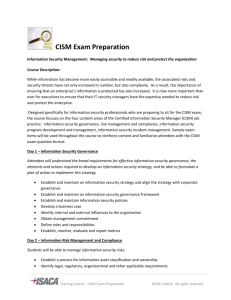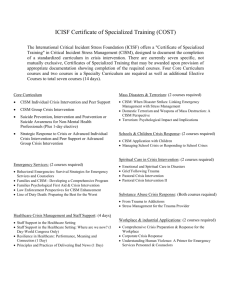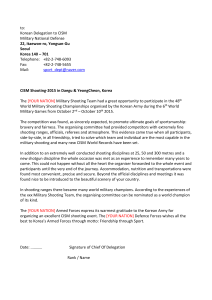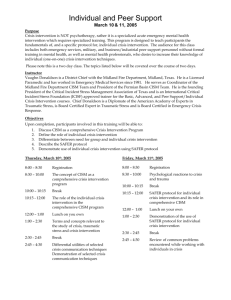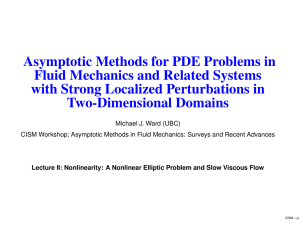Asymptotic Methods for PDE Problems in Fluid Mechanics and Related Systems
advertisement
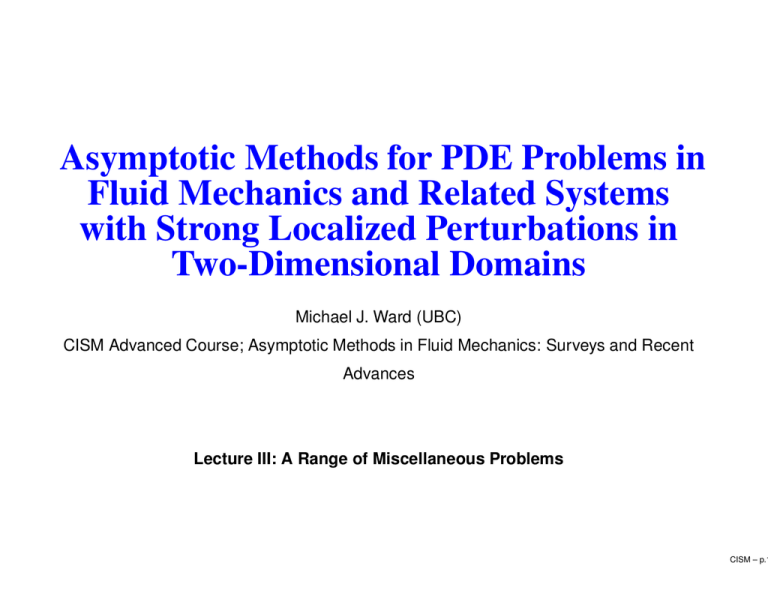
Asymptotic Methods for PDE Problems in
Fluid Mechanics and Related Systems
with Strong Localized Perturbations in
Two-Dimensional Domains
Michael J. Ward (UBC)
CISM Advanced Course; Asymptotic Methods in Fluid Mechanics: Surveys and Recent
Advances
Lecture III: A Range of Miscellaneous Problems
CISM – p.1
Outline of Lecture II
SPECIFIC PROBLEMS CONSIDERED:
1. Slow Viscous Flow Over a Cylinder with Asymmetric Cross-section
2. Linear Biharmonic BVP with Holes (Problem 5)
3. A Nonlinear Biharmonic BVP: Concentration Phenomena
4. Remarks on Low Peclet Number Flow (Problem 6)
5. Remarks on Localized Solutions in Other Contexts
CISM – p.2
Slow Viscous Flow Over a Cylinder
Consider slow, steady, two-dimensional flow of a viscous incompressible
fluid around an infinitely long straight cylinder. The Reynolds number
satisfies ε ≡ U∞ L/µ 1 where U∞ is the velocity of the fluid in the
x-direction at infinity, µ is the kinematic viscosity, and 2L is the diameter of
the cross-section of the cylinder.
Assume first that the cross-sectional shape Ω of the cylinder is
asymmetric about the direction of the oncoming stream, The
dimensionless stream function ψ satisfies
42 ψ + ε Jρ [ψ, 4ψ] = 0 ,
ψ = ∂n ψ = 0 ,
ψ ∼ y,
for ρ > ρb (θ) ,
on ρ = ρb (θ) ,
as ρ = (x2 + y 2 )1/2 → ∞ .
(2.1a)
(2.1b)
(2.1c)
Here Jρ is the Jacobian defined by Jρ [a, b] ≡ ρ−1 (∂ρ a ∂θ b − ∂θ a ∂ρ b). The
boundary of the cross-section is ρ = ρb (θ) for −π ≤ θ ≤ π.
CISM – p.3
Slow Viscous Flow: Asymmetric Body I
For an asymmetric body, not aligned with the stream, a similar hybrid
method can be formulated:
In the Oseen region we must solve
∆2 ΨH + Jr (ΨH , ∆ΨH ) = 0 ,
ΨH ∼ ρ sin θ,
ΨH ∼ A(ε) · [x + ν(ε)x log |x| + ν(ε)Mx] ,
r > 0,
(2.2a)
r → ∞,
(2.2b)
r→0
(2.2c)
Notice again that we have a constraint to determine the vector A.
In the Stokes region, the vector function ψ c (ρ, θ) = (ψcx (r, θ), ψcy (r, θ)) is
the canonical inner solution satisfying
∆2 ψ c = 0,
∂ψ c
= 0,
∂n
ψ c ∼ y log |y| + My ,
ψc =
(ρ, θ) 6∈ Ω0 ,
(2.3a)
(ρ, θ) ∈ ∂Ω0 ,
(2.3b)
ρ = |y| → ∞ .
(2.3c)
Here M is a 2 × 2 matrix that depends on the shape of the body. It can
be found analytically for an ellipse at an angle of inclination
CISM – p.4
Slow Viscous Flow: Asymmetric Body II
The drag and lift coefficients are given in terms of A by
(CL , −CD ) = −
4π
[ν(ε)A(ε) + · · · ],
ε
ν(ε) = −1/ log ε.
(2.4)
For an ellipse of semi-axes a and b at an angle of elevation α to the
free-stream
2
a+b
(b − a) cos α − b
,
m11 =
− log
(2.5a)
a+b
2
(a − b) sin α cos α
,
m12 = m21 =
(2.5b)
a+b
a+b
(a − b) cos2 α − a
m22 =
(2.5c)
− log
.
a+b
2
For other shapes fast boundary integral methods based on Goursat’s
complex variable formula can be used (Greengard, Kropinski, Mayo
(1996)).
CISM – p.5
Slow Viscous Flow: Asymmetric Body III
For an ellipse at an angle α of inclination, the leading-order (first term in
log expansion) lift coefficient is
CL =
4π
a−b
sin α cos α.
2
ε(log ε) a + b
(2.6)
A two-term expansion for CL was found by Shintani et al. (1983);
a−b
4π
sin 2α,
(CL )S ∼
R(log R − t+ )(log R − t− ) a + b
(2.7)
where
t± = −γ +4 log(2)−log[1+b/a]±
1
2
(
1+2
a−b
a+b
cos 2α +
a−b
a+b
2 ) 12
.
Here, R = 2ε and γ = 0.5772 . . . is Euler’s constant.
CISM – p.6
Slow Viscous Flow: Asymmetric Body IV
25
C (hybrid)
L
C (Shintani et al.)
L
C (leading−order)
20
L
Lift coefficient
15
10
5
0
−5
0.1
0.2
0.3
0.4
0.5
0.6
ε (Reynolds number)
0.7
0.8
0.9
1
Figure 1: Lift coefficient, CL , versus Reynolds number, ε, of an elliptic
cylinder with major semi-axis a = 1 and minor semi-axis b = 0.5 at an angle
of inclination, α = π/4, comparing the hybrid results with the leading-order
form and the two-term result of Shintani et al.
CISM – p.7
Slow Viscous Flow: Asymmetric Body V
Now apply the hybrid method to a more complicated object. We need only
modify the body-shape matrix M to compute the force coefficients, C D
and CL . The boundary profile of the object is
x = ξ cos β − η sin β,
ξ=
y = ξ sin β + η cos β,
b + a sin θ − (b + a sin θ)
b
a cos θ + a cos θ
cos(N θ) ,
,
η
=
+
2
2
2
2
(a cos θ) + (b + a sin θ)
(a cos θ) + (b + a sin θ)
3
with 0 ≤ θ < 2π. We choose β = −0.3, a = 1.2, b = 0.3, N = 8.
1
0.8
0.6
y
0.4
0.2
0
−0.2
−0.4
−0.6
−1
−0.5
0
x
0.5
1
CISM – p.8
Slow Viscous Flow: Asymmetric Body VI
By using fast boundary integral methods based on Goursat’s complex
variable formula (Ref: Greengard, Kropinski, Mayo (1996)).
"
#
−1.0019045557844 0.1550966443197
M=
.
0.1550966443197
−0.5484962829688
The Drag and Lift coefficients are as shown:
Drag Coefficient
60
50
40
CD
30
20
10
0
0.1
0.2
0.3
0.4
0.5
0.6
0.7
0.8
0.4
0.5
ε (Reynolds number)
0.6
0.7
0.8
ε
Lift Coefficient
5
4
CL
3
2
1
0.1
0.2
0.3
CISM – p.9
Problem 5 From Notes
Consider the Biharmonic equation in the two-dimensional
concentric annulus, formulated as
Problem 5:
42 u = 0 ,
u=f,
x ∈ Ω\Ωε ,
ur = 0 ,
u = ur = 0 ,
(5.1a)
on r = 1 ,
(5.1b)
r = ε.
(5.1c)
Here Ω is the unit disk centered at the origin, containing a small hole of
radius ε centered at x = 0, i.e. Ωε = {x | |x| ≤ ε}. Consider the following
two choices for f : Case I: f = 1. Case II: f = sin θ. For each of these two
cases calculate the exact solution, and from it determine an approximation
to the solution in the outer region |x| O(ε). Can you re-derive these
results from singular perturbation theory in the limit ε → 0?.
The leading-order outer problem for Case I is different from what
you might expect.
Remark 1:
For Case 2 one can sum an infinite logarithmic expansion in a
similar way as for slow viscous flow. The result can then be verified from
the exact solution.
Remark 2:
CISM – p.10
Solution to Problem 5 From Notes: I
Solution:
Case I: We
consider the perturbed problem
42 u = 0 ,
u = 1,
ε < r < 1,
ur = 0 ,
u = ur = 0 ,
on r = 1 ,
on r = ε .
(5.2a)
(5.2b)
(5.2c)
We first find the exact solution of this problem and expand it for ε → 0.
Since the radially symmetric solutions are linear combinations of
{r 2 , r 2 log r, log r, 1}, the solution to (5.2a,b) is
2
u = A r − 1 + Br 2 log r − (2A + B) log r + 1 ,
(5.3)
for any constants A and B. Then, imposing that u = ur = 0 on r = ε, we
get two equations for A and B:
2
2
2
(5.4a)
2A 1 − ε A + B 1 − ε − 2ε log ε = 0 ,
2
2
A 1 + 2 log ε − ε + B 1 − ε log ε = 1 .
(5.4b)
CISM – p.11
Solution to Problem 5 From Notes: II
Equation (5.4a) gives
B
A=−
2
2ε2 log ε
1−
1 − ε2
(5.5)
.
Upon substituting this into (5.4b), we obtain that B satisfies
2ε2 log ε
2 log ε
1
B
1−
1+
+ B log ε =
−
2
1 − ε2
1 − ε2
1 − ε2
(5.6a)
which reduces after some algebra to
−
B
+ 2ε2 (log ε)2 B ∼ 1 + O(ε2 ) .
2
(5.6b)
This determines B, while (5.5) determines A. Therefore,
2
B ∼ −2 − 8ε2 (log ε) ,
2
A ∼ 1 + 4ε2 (log ε) .
(5.7)
CISM – p.12
Solution to Problem 5 From Notes: III
Upon substituting (5.7) into (5.3), we obtain the following two-term
expansion in the outer region r O(ε):
u ∼ u0 (r) + ε2 (log ε)2 u1 (r) + · · · ,
(5.8a)
2
(5.8b)
where u0 (r) and u1 (r) are defined by
2
u0 (r) = r − 2r log r ,
2
u1 = 4 r − 1 − 8r 2 log r .
It is interesting to note that the leading-order outer solution u 0 (r) is not a
C 2 smooth function as r → 0, but that it does satisfy the point constraint
u0 (0) = 0.
Hence, in the limit of small hole radius the ε-dependent solution does not
tend to the unperturbed solution in the absence of the hole. This
unperturbed solution would have B = 0 and A = 0 in (5.3), and
consequently u = 1 in the outer region.
CISM – p.13
Solution to Problem 5 From Notes: IV
Next, we show how to recover (5.8) from a matched asymptotic expansion
analysis. In the outer region we expand the solution as
(5.9)
u ∼ w0 + σw1 + · · · ,
where σ 1 is an unknown gauge function, and where w0 satisfies:
4 2 w0 = 0 ,
0 < r < 1;
w0 (1) = 1 ,
w0r (1) = 0 ,
w0 (0) = 0 . (5.10)
The solution is readily calculated as
The problem for w1 is
4 2 w1 = 0 ,
w0 = r 2 − 2r 2 log r .
(5.11)
0 < r < 1;
(5.12)
w1 (1) = w1r (1) = 0 .
Its solution is given in terms of unknown coefficients α1 and β1 as
2
w1 = α1 r − 1 + β1 r 2 log r − (2α1 + β1 ) log r .
(5.13)
The behavior of w1 as r → 0, as found below by matching to the inner
solution, will determine α1 and β1 .
CISM – p.14
Solution to Problem 5 From Notes: V
In the inner region we set r = ερ and obtain from (5.11) that the terms of
order O(ε2 log ε) and O(ε2 ) will be generated in the inner region.
Therefore, this suggests that in the inner region we expand the solution as
2
(5.14)
v(ρ) = ε log ε v0 (ρ) + ε2 v1 (ρ) + · · · .
The functions v0 and v1 must satisfy vj (1) = vjρ (1) = 0. Therefore, we
obtain for j = 0, 1 that
2
(5.15)
vj = Aj ρ − 1 + Bj ρ2 log ρ − (2Aj + Bj ) log ρ .
We substitute (5.15) into (5.14), and write the resulting expression in
terms of the outer variable r = ερ.
CISM – p.15
Solution to Problem 5 From Notes: VI
A short calculation gives that the far-field behavior of (5.14) is
2
2
2
2
v ∼ − (log ε) B0 r + (log ε) (A0 − B1 )r + B0 r log r +
2
A1 r 2 + B1 r 2 log r + 2A0 ε2 (log ε) + O(ε2 log ε) .
(5.16)
In contrast, the two-term outer solution from (5.9), (5.11) and (5.13) is
2
2
2
2
u ∼ r − 2r log r + σ α1 r − 1 + β1 r log r − (2α1 + β1 ) log r + · · · .
(5.17)
Upon comparing (5.16) with (5.17), we conclude that
B0 = 0 ,
B 1 = A0 ,
A1 = 1 ,
B1 = −2 ,
2
σ = ε2 (log ε) .
(5.18)
The constant term −4ε2 (log ε)2 on the right-hand side of (5.16) is
unmatched. Consequently, w1 is bounded as r → 0 and has the point
value w1 (0) = −4. Thus, 2α1 + β1 = 0 and α1 = 4 in (5.17). This gives
β1 = −8, and specifies the second-order term (reproducing the exact
solution) as
2
(5.19)
w1 = 4 r − 1 − 8r 2 log r .
CISM – p.16
Solution to Problem 5 From Notes: VII
It is impossible to match to an outer solution u0 that does not
satisfy the point constraint u0 (0) = 0. In addition, we further remark that
point constraints are possible with the Biharmomic operator, since the
2
free-space Green’s function has singularity O |x − x0 | log |x − x0 | as
x → x0 . However, with a point constraint we will not have C 2 smoothness.
Remark:
Satisfying point constraints with the biharmonic operator is the basis of
what is known as Biharmonic interpolation.
CISM – p.17
Solution to Problem 5 From Notes: VIII
Case II:
Next, we consider the perturbed problem
42 u = 0 ,
u = sin θ ,
ur = 0 ,
u = ur = 0 ,
(5.20a)
ε < r < 1,
on r = 1 ,
(5.20b)
on r = ε .
(5.20c)
We first find the exact solution of (5.20) and expand it for ε → 0. Since the
solutions to (5.20) proportional to sin θ are linear combinations of
{r 3 , r log r, r, r −1 } sin θ, the solution to (5.20a,b) is
1
B 1
1 B
r+
sin θ ,
+A+
u = Ar 3 + Br log r + −2A + −
2
2
2
2 r
(5.21)
for any A and B. Then, imposing that u = ur = 0 on r = ε, we get
1
B
1 B
ε+
+A+
ε−1 = 0 ,
Aε3 + Bε log ε + −2A + −
2
2
2
2
(5.22a)
3Aε2 + B + B log ε + −2A +
1 B
−
2
2
−
1
B
+A+
2
2
ε−2 = 0 .
(5.22b)
CISM – p.18
Solution to Problem 5 From Notes: IX
By comparing the O(ε−1 ) and O(ε−2 ) terms in (5.22), it follows that
B
1
+A+
= κε2 ,
2
2
(5.23)
where κ is an O(1) constant to be found. Substituting (5.23) into (5.22),
and neglecting the higher order Aε3 and 3Aε2 terms in (5.22), we get
1 B
1 B
≈ −κ , B + B log ε + −2A + −
≈ κ.
B log ε + −2A + −
2
2
2
2
Add the two equations to eliminate κ, to get
B + 2B log ε + (−4A + 1 − B) = 0 .
(5.24)
(5.25)
From (5.25), together with A ∼ −(1 + B)/2 from (5.23), we obtain that
3ν
,
B∼
2−ν
3
A=1−
,
2−ν
−1
.
where ν ≡
1/2
log εe
(5.26)
CISM – p.19
Solution to Problem 5 From Notes: X
Finally, substituting (5.26) into (5.21), we obtain that the outer solution has
the asymptotics
(5.27a)
u ∼ (1 − Ã)r 3 + ν Ãr log r + Ãr sin θ , r O(ε) .
where à is defined by
à ≡
3
,
2−ν
ν≡
−1
.
1/2
log εe
(5.27b)
We remark that (5.27) is an infinite-order logarithmic series approximation
to the exact solution. However, it does not contain transcendentally small
terms of algebraic order in ε as ε → 0.
Notice again the loss of smoothness, this time proportional to a directional
derivative of the free-space Green’s function.
CISM – p.20
Solution to Problem 5 From Notes: XI
Next, we show how to derive (5.27) by employing the hybrid formulation
used to treat the slow viscous flow problem.
In order to sum the infinite logarithmic series we formulate a hybrid
method with a singularity structure. In the inner region, with inner variable
ρ ≡ ε−1 r, we look for an inner (Stokes) solution in the form
1
ρ
sin θ .
(5.28)
v(ρ, θ) = u(ερ, θ) ∼ εν Ã(ν) ρ log ρ − +
2 2ρ
1/2 Here ν ≡ −1/ log εe
and à ≡ Ã(ν) is a function of ν to be found. The
extra factor of ε in (5.28) is needed since the solution in the outer region is
not algebraically large as ε → 0.
Now letting ρ → ∞, and writing (5.28) in terms of the outer variable
r = ερ, we obtain that the far-field form of (5.28) is
v ∼ Ãνr log r + Ãr sin θ .
(5.29)
CISM – p.21
Solution to Problem 5 From Notes: XII
Therefore, the hybrid solution wH to (5.20) that sums all the logarithmic
terms must satisfy
4 2 wH = 0 ,
0 < r < 1,
wH = sin θ , wHr = 0 , on r = 1 ,
wH ∼ Ãνr log r + Ãr sin θ , as r → 0 .
(5.30a)
(5.30b)
(5.30c)
Note: a singularity structure with regular and singular parts specified
The solution to (5.30a,b) in terms of unknown constants α and β is
1
1
β
β
1
3
r+
sin θ .
+α+
wH = αr + βr log r + −2α + −
2
2
2
2 r
The condition (5.30c) then yields three equations for α, β, and Ã:
β = Ãν ,
−2α +
1 β
− = Ã ,
2
2
1
β
+ α + = 0,
2
2
(5.31)
(5.32)
CISM – p.22
Solution to Problem 5 From Notes: XIII
We solve to obtain
β = Ãν ,
3
,
à =
2−ν
α = 1 − Ã .
(5.33)
Upon substituting (5.33) into (5.31), we obtain that this agrees with the
asymptotics of the exact solution.
This simple example of Case II has shown explicitly, without numerical
methods, that the hybrid asymptotic numerical method for summing
infinite logarithmic expansions agrees with the results that can be
obtained from the exact solution.
CISM – p.23
Linear Biharmonic BVP I
Consider the deflection of a plate with N holes that is subject to a loading:
2
4 u = F (x) ,
x ∈ Ω\Ωp
u = ∂n u = 0,
x ∈ ∂Ω .
u = ∂n u = 0,
N
Ωp ≡ ∪ Ωε j ,
j=1
(6.1a)
(6.1b)
(6.1c)
x ∈ ∂Ωεj , j = 1, . . . , N .
Let up (x) solve the unperturbed problem
42 up = F (x) ,
x ∈ Ω;
u p = ∂n u p = 0 ,
We look for a two-term asymptotic solution in the form
u = u0 + σu1 + · · · ,
x ∈ ∂Ω .
(6.2)
(6.3)
where we must impose that u0 satisfy the point constraints u0 (xj ) = 0 for
j = 1, . . . , N . The leading-order solution u0 has the form
u0 = up +
N
X
Ai G(x; xi ) .
(6.4)
i=1
CISM – p.24
Linear Biharmonic BVP II
The coefficients Ai are determined from the Biharmonic interpolation
equations
N
X
Ai G(xj ; xi ) = −up (xj ) .
(6.5)
i=1
Here G(x; ξ) is the Biharmonic Green’s function satisfying
42 G = δ(x − ξ) ,
x ∈ Ω;
G = ∂n G = 0 ,
x ∈ ∂Ω .
(6.6)
Then, G(x; ξ) can be written in terms of a singular and regular part as
G(x; ξ) =
1
|x − ξ|2 log |x − ξ| + R(x; ξ) .
8π
(6.7)
For the unit disk |x| = r with r < 1 with ξ = 0, then
G(x; 0) =
1
1 2
r log r −
(r 2 − 1) .
8π
16π
Expanding the outer solution u0 as x → xj yields
u0 + σu1 ∼ aj · (x − xj ) + · · · + σu1 + · · · ,
as x → xj
(6.8)
(6.9)
CISM – p.25
Linear Biharmonic BVP III
In the j th inner region we write y = ε−1 (x − xj ) and get Stokes equation.
The inner solution has the form
v = νaj · ψ c + · · ·
(6.10)
where ψ c is the vector Stokes solution for low Re flow
∆2 ψ c = 0,
∂ψ c
= 0,
∂n
ψ c ∼ y log |y| + Mj y ,
ψc =
(ρ, θ) 6∈ Ωj ,
(6.11a)
(ρ, θ) ∈ ∂Ωj ,
(6.11b)
ρ = |y| → ∞ .
Writing the far-field form for v in outer variables, and choosing
ν = −1/ log ε, we get
v ∼ aj · (x − xj ) + ν [aj · (x − xj ) log |x − xj | + aj · Mj (x − xj )]
(6.11c)
(6.12)
Therefore, σ = ν = −1/ log ε and we cn find a problem for u1 etc....
Remark: This problem is essentially Case II and we can formulate a
problem to sum the infinite logarithmic expansions etc..
CISM – p.26
Problem 6 From Notes: I
Consider the following convection-diffusion equation for T (X),
with X = (X1 , X2 ) posed outside two circular disks Ωj for j = 1, 2 of a
common radius a, and with a center-to-center separation 2L between the
two disks:
Problem 6:
κ4T = U · ∇T ,
T = Tj ,
T ∼ T∞ ,
X ∈ R2 \ ∪2j=1 Ωj ,
X ∈ ∂Ωj ,
j = 1, 2 ,
|X| → ∞ .
(7.1a)
(7.1b)
(7.1c)
Here κ > 0 is constant, Tj for j = 1, 2 and T∞ are constants, and
U = U(X) is a given bounded flow field with U(X) → (U∞ , 0) as
|X| → ∞, where U∞ is constant.
Non-dimensionalize (7. 1) in terms of U∞ and the length-scale
γ = κ/U∞ to derive a convection-diffusion equation outside of two
circular disks of radii ε ≡ U∞ a/κ, with inter-disk separation 2Lε/a.
Here ε is the Peclet number.
CISM – p.27
Problem 6 From Notes: II
In the low Peclet number limit ε → 0 show how a hybrid
asymptotic-numerical solution can be implemented to sum the infinite
logarithmic expansions for two different distinguished limits: Case 1:
L/a = O(1). Case 2: L/a = O(ε−1 ).
For a uniform flow with U = (U∞ , 0) for X ∈ R2 , determine the required
Green’s function and its regular part.
For Case 1, we require an explicit formula for the logarithmic
capacitance, d, of two disks of a common radius, a, and with a
center-to-center separation of 2l. The result is
Remark:
∞
X
e−mξc
ξc
+
,
log d = log (2β) −
2
m cosh(mξc )
m=1
where β and ξc are determined in terms of a and l by
s 2
p
l
l
ξc = log +
− 1 .
β = l 2 − a2 ;
a
a
(7.2)
(7.3)
CISM – p.28
Solution to Problem 6 From Notes: I
Solution:
We introduce the dimensionless variables x, u(x), and w(x) by
x = X/γ ,
T = T∞ w ,
u(x) = U(γx)/U∞ ,
γ ≡ κ/U∞ .
(7.4)
We define the dimensionless centers of the two circular disks by xj for
j = 1, 2, and their constant boundary temperatures αj for j = 1, 2, by
xj = Xj /γ ,
αj = wj /T∞ ,
j = 1, 2 .
(7.5)
Then, (7. 1) transforms in dimensionless form to
4w = u · ∇w ,
w = αj ,
w ∼ 1,
x ∈ R2 \ ∪2j=1 Dεj ,
x ∈ ∂Dεj ,
j = 1, 2 ,
|x| → ∞ .
(7.6a)
(7.6b)
(7.6c)
Here Dεj = {x | |x − xj | ≤ ε} is the circular disk of radius ε centered at
xj . The center-to-center separation is
|x2 − x1 | = 2lε ,
l ≡ L/a .
The dimensionless flow has limiting behavior u ∼ (1, 0) as |x| → ∞.
(7.7)
CISM – p.29
Solution to Problem 6 From Notes: II
Assume that l = O(1) as ε → 0, so that |x2 − x1 | = O(ε). This is
the case where the bodies are close together; it leads to a new type of
inner problem.
Case 1:
Assume WLOG that x1 + x2 = 0. Introduce the inner variables
y = ε−1 x ,
v(y) = w(εy) .
(7.8)
Then, (7.6a,b) transforms to
4y v = εu0 · ∇y v ,
v = αj ,
y ∈ R2 \ ∪2j=1 Dj ,
y ∈ ∂Dj ,
j = 1, 2 ,
(7.9a)
(7.9b)
Here Dj = {y | |y − yj | ≤ 1} is the circular disk centered at yj = xj /ε of
radius one, and u0 ≡ u(0). The inter-disk separation is
|y2 − y1 | = 2l .
(7.10)
Look for a solution to (7.9) in the form
v = v0 + νAvc ,
where ν = O(−1/ log ε) and A = A(ν) is to be found.
(7.11)
CISM – p.30
Solution to Problem 6 From Notes: III
Here v0 is the solution to
4 y v0 = 0 ,
v0 = α j ,
y ∈ R2 \ ∪2j=1 Dj ,
y ∈ ∂Dj ,
j = 1, 2 ,
v0 bounded as |y| → ∞ .
(7.12a)
(7.12b)
(7.12c)
Moreover, vc (y) is the solution to
4 y vc = 0 ,
vc = 0 ,
vc ∼ log |y| ,
y ∈ R2 \ ∪2j=1 Dj ,
y ∈ ∂Dj ,
j = 1, 2 ,
as |y| → ∞ .
(7.13a)
(7.13b)
(7.13c)
Since Dj for j = 1, 2 are non-overlapping circular disks, (7.12) can be
solved explicitly using conformal mapping. This gives
v0 ∼ v0∞ + o(1) ,
as |y| → ∞ .
(7.14)
When α1 = α2 = αc , then clearly v0∞ = α1 .
CISM – p.31
Solution to Problem 6 From Notes: IV
Next, we solve (7.13) exactly by introducing bipolar coordinates to get
vc (y) ∼ log |y| − log d + o(1) ,
|y| → ∞ ,
(7.15)
where d is given by setting a = 1 in (7.2) and (7.3).
Upon substituting (7.14) and (7.15) into (7.11), the far-field behavior of v
gives the required singularity structure for the outer hybrid solution V0 as
V0 ∼ v0∞ + A + νA log |x| ,
as x → 0 ;
ν≡
−1
.
log (εd)
(7.16)
Therefore, to sum the logarithmic expansion we must solve
4V0 = u · ∇V0 ,
x ∈ R2 \{0} ;
with singularity structure (7.16) as x → 0.
V0 ∼ 1 ,
|x| → ∞ ,
(7.17)
In this analysis we have neglected the transcendentally small
O(ε) term in (7.9), representing a weak drift in the inner region.
Remark:
CISM – p.32
Solution to Problem 6 From Notes: V
To solve for V0 we use Green’s function G(x; ξ) satisfying
4G = u · ∇G − δ(x − ξ) ,
G(x; ξ) ∼ −
x ∈ R2 ,
1
log |x − ξ| + R(ξ; ξ) + o(1) ,
2π
x → ξ,
(7.18a)
(7.18b)
with G(x; ξ) → 0 as |x| → ∞. Here R(ξ; ξ) is the regular part of G.
The solution to (7.17) with singular behavior V0 ∼ νA log |x| as x → 0 is
V0 = 1 − 2πνAG(x; 0) .
(7.19)
By expanding (7.17) as x → 0, and equating the regular part of the
resulting expression with that in (7.16), we determine A(ν) as
1 − v0∞
,
A=
1 + 2πνR00
−1
,
ν≡
log(εd)
R00 ≡ R(0; 0) .
(7.20)
The outer and inner solutions are then given in terms of A. Finally, one
can calculate the Nusselt number, representing the average heat flux
across the bodies etc...
CISM – p.33
Solution to Problem 6 From Notes: VI
Assume l = O(ε−1 ) as ε → 0, and define l = l0 /ε with l0 = O(1),
so that |x2 − x1 | = 2l0 .
Case 2:
This is the case where the small disks of radius ε are separated by O(1)
distances in (7.6).
There are now two distinct inner regions; one near x1 and the other at an
O(1) distance away centered at x2 . Since each separated disk is a circle
of radius ε, it has a logarithmic capacitance d = 1.
Therefore, the infinite-logarithmic series approximation V0 (x; ν) to the
outer solution satisfies
4V0 = u · ∇V0 ,
x ∈ R2 \{0} ;
V0 ∼ 1 ,
V0 ∼ αj + Aj + νAj log |x − xj | ,
|x| → ∞ ,
−1
.
ν≡
log ε
(7.21a)
(7.21b)
The solution to (7.21) is given explicitly by
V0 = 1 − 2πν
2
X
Ai G(x; xi ) .
(7.22)
i=1
CISM – p.34
Solution to Problem 6 From Notes: VII
Let x → xj for j = 1, 2 in (7.22) and equate the nonsingular part of the
resulting expression with the regular part of the singularity structure in
(7.21b) This yields a 2 × 2 system for A1 and A2 :
A1 (1 + 2πνR11 ) + 2πνA2 G12 = 1 − α1 ;
A2 (1 + 2πνR22 ) + 2πνA1 G21 = 1 − α2 .
(7.23a)
(7.23b)
where Gij = G(xj ; xi ) and Rjj = R(xj ; xj ) are the Green’s function and
its regular part.
For uniform flow where u = (1, 0), then
x1 − ξ 1
1
1
K0 (|x − ξ|) , R(ξ, ξ) =
exp
(log 2 − γe ) .
G(x; ξ) =
2π
2
2π
A similar result for G and R can be found for a shear flow etc..
(7.24)
These results for G and its regular part can be used in the results of either
Case I or Case II.
CISM – p.35
Other Problems: Ostwald Ripening I
A similar hybrid method can be used for some time-dependent problems
with localized solutions:
Ostwald Ripening: The diffusive evolution of small particles during the late
stage coarsening of a first order phase transformation. The chemical
potential u(x; ε), satisfies
in domain D, outside of N particles
u = H, on i-th particle boundary, ∂Diε , i = 1, . . . , N
∆u = 0,
∂u
= 0, on domain boundary
∂n
s {
∂u
V =−
, on i-th particle boundary, ∂Diε , i = 1, . . . , N
∂n
“Small area fraction”: N particles of size O(ε) a distance O(1) apart
H is curvature; V is normal velocity of interface (such that V > 0 for a
shrinking particle); J·K denotes the jump in the bracketed quantity
Previous 2D studies (unbounded domain): Voorhees et al. 1988, Zhu
et al. 1996, Levitan & Domany 1998, ..
What is the effect of: boundary of the domain, particle interaction?
CISM – p.36
Other Problems: Ostwald Ripening II
Radii ri (t) and centers ξ i evolve in time
Define local radius ρi = |x − ξi |/ε = ri /ε
For circular particles, curvature of ith particle is 1/(ερi )
Normal velocity of interface, V = −dri /dt = −d(ερi )/dt
Can write problem for concentration u(x; ε) as
∆u = 0,
x ∈ Ω\{outside disks} ;
1
u=
,
ερi
1 ∂u
dρi
= 2
,
dt
ε ∂ρ
∂u
= 0,
∂n
x ∈ ∂Ω ,
on i-th particle boundary
(7.25a)
(7.25b)
Use hybrid method to derive ODE’s for the centers and radii of the
particles.
Too Late: N. Alikakos, G. Fusco, G. Karali, Ostwald Ripening in Two
Dimensions: The Rigorous Derivation of the Equations from the
Mullins-Sekerka Dynamics, Journ. Diff. Eq., 205(1), (2004), pp. 1–49.
Largely Open: Study Ostwald Ripening and Migration Phenomena of Small
Droplets in Fourth Order Fluid Film Models using Hybrid method (Glasner,
SIAM 2008) (Ref: F. Otto, D. Slepcev, etc..)
CISM – p.37
Other Problems: Spot Patterns in RD: I
Schnakenburg Model:
2-D domain Ω with ∂n u = ∂n v = 0 on ∂Ω:
vt = ε2 ∆v − v + uv 2 ,
ε2 ut = D∆u + a − ε−2 uv 2 .
Here 0 < ε 1, with D > 0, and a > 0, are parameters.
Spot pattern: since ε 1, v can concentrate at discrete points in Ω.
Semi-strong Regime: D = O(1) so that u is global.Weak Interaction Regime:
D = O(ε2 ) so that u is localized.. We assume semi-strong.
The ferrocyanide-iodate-sulphite
reaction (Swinney et al, Nature, 1994), the chloride-dioxide-malonic
acid reaction (De Kepper et al, J. Phys. Chem, 1998), and certain
semiconductor gas discharge systems (Purwins et al, Phys. Lett. A,
2001)
Physical Experiments of Spot-Splitting:
Many studies (Pearson,
Nishiura, Muratov, Maini) for related models, i.e. the Gray-Scott (GS)
model
Numerical Results of Spot-Splitting in 2-D:
vt = ε2 ∆v − v + Auv 2 ,
τ ut = D∆u + (1 − u) − uv 2 .
CISM – p.38
Other Problems: Spot Patterns in RD: II
Ref:
Kolokolnikov, Ward, Wei, J. Nonl. Sci., V. 19, No. 1, (2009), p. 1–56.
Slow Dynamics:
a DAE system for the evolution of K spots.
Spot-Splitting Instability
Example:
peanut-splitting and the splitting direction.
Ω = [0, 1]2 , ε = 0.02, a = 51, D = 0.1.
t = 4.0
t = 280.3
t = 25.5
t = 460.3
t = 40.3.
t = 940.3.
CISM – p.39
Other Problems: Spot Patterns in RD: III
Construction of a One-Spot Pattern by Singular Perturbation Techniques:
Inner Region:
near the spot location x0 ∈ Ω introduce V(y) and U(y) by
1
u= √ U,
D
v=
√
DV ,
y = ε−1 (x − x0 ) ,
x0 = x0 (ε2 t) .
To leading order, U ∼ U (ρ) and V ∼ V (ρ) (radially symmetric) with ρ = |y|.
This yields the coupled core problem with U 0 (0) = V 0 (0) = 0, where:
1
1
2
0 < ρ < ∞,
Vρρ + Vρ − V + U V = 0 , Uρρ + Uρ − U V 2 = 0 ,
ρ
ρ
V → 0,
U ∼ S log ρ + χ(S) + o(1) , as ρ → ∞ .
Here S > 0 is called the “source strength” and is a parameter to be
determined upon matching to an outer solution.
The nonlinear function χ(S) must be computed numerically.
CISM – p.40
Other Problems: Spot√ Patterns in RD: IV
Outer Region:
v 1 and ε−2 uv 2 → 2π DSδ(x − x0 ). Hence,
2π
a
∆u = − + √ S δ(x − x0 ) , x ∈ Ω ; ∂n u = 0 , x ∈ ∂Ω ,
D
D
S
1
√
S log |x − x0 | + χ(S) +
as x → x0 , ν ≡ −1/ log ε .
u∼
ν
D
the regular part of this singularity structure is specified and was
obtained from matching to the inner core solution.
Key Point:
Divergence theorem yields S (and inner core solution U and V ) as
S=
a|Ω|
√ .
2π D
The outer solution is given uniquely in terms of the Neumann
G-function
2π
u(x) = − √ (SG(x; x0 ) + uc ) ,
D
where S + 2πνSR(x0 ; x0 ) + νχ(S) = −2πνuc ,
ν ≡ −1/ log ε .
CISM – p.41
Other Problems: Spot Patterns in RD: V
Collective Coordinates: Sj , xj , for j = 1, . . . , K.
Principal Result: (DAE System): For “frozen” spot
locations xj , the source
strengths Sj and uc satisfy the nonlinear algebraic system
N
X
Si Gj,i + νχ(Sj ) = −2πνuc , j = 1, . . . , K ,
Sj + 2πν Sj Rj,j +
j=1
j6=i
K
X
j=1
Sj =
a|Ω|
√ ,
2π D
ν≡
−1
.
log ε
The slow dynamics of the spots with speed O(ε2 ) satisfies
N
X
Si ∇G(xj ; xi ) , j = 1, . . . , K .
x0j ∼ −2πε2 γ(Sj ) Sj ∇R(xj ; xj ) +
j=1
j6=i
Here Gj,i ≡ G(xj ; xi ) and Rj,j ≡ R(xj ; xj ) (Neumann G-function).
CISM – p.42
References
Our papers available at:
http://www.math.ubc.ca/ ward/prepr.html
J. B. Keller, M. J. Ward, Asymptotics Beyond All Orders for a Low
Reynolds Number Flow, J. Engrg. Math., 30(1-2), (1996), pp. 253–265.
M. Titcombe, M. J. Ward, M. C. Kropinski, A Hybrid
Asymptotic-Numerical Solution for Low Reynolds Number Flow Past
an Asymmetric Cylindrical Body, Stud. Appl. Math., 105(2), (2000),
pp. 165–190.
K. Shintani, A. Umemura, A.. Takano, Low Reynolds-number flow past
an elliptic cylinder, J. Fluid Mech., 136, (1983), pp. 277-289.
M. Titcombe, M. J. Ward, Convective Heat Transfer Past Small
Cylindrical Bodies, Stud. Appl. Math., 99(1), (1997), pp. 81-0105.
K. Glasner, Ostwald Ripening in Thin Film Equations, SIAM J. Appl.
Math., 69(2), (2008), pp. 473–493.
N. Alikakos, G. Fusco, G. Karali, Ostwald Ripening in Two Dimensions:
The Rigorous Derivation of the Equations from the Mullins-Sekerka
Dynamics, Journ. Diff. Eq., 205(1), (2004), pp. 1–49.
M. C. Kropinski, A. Lindsay, M. J. Ward, An Asymptotic Analysis of
Localized Solutions to Some Linear and Nonlinear Biharmonic
Eigenvalue Problems in Two-Dimensional Domains, in preparation.
CISM – p.43
